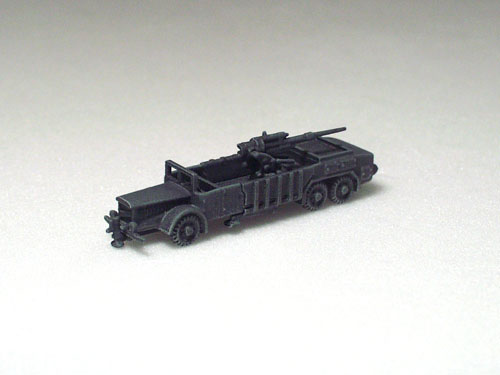

1:144 Kampfgruppe144 X CGD
Black Label Series
88mm Flak (Motorised) Sd.Kfz “VOMAG”
[early version]


The VOMAG is one of the most interesting vehicles in the inventory of Wehrmacht in WWII. It was not as some think a ‘paper panzer’, but a real operational vehicle that saw combat across Europe.
The development of the VOMAG is an interesting one, based upon the Vogtländische Maschinenfabrik AG (VOMAG) design for the Büssing NAG 900L. The chassis had three axles, two of which were driven, and was powered by a 6-cylinder diesel engine that was capable of reaching 90 km / h. (55 mph). A total of 24 units were constructed
It was armed with the 88mm Flak 18, but with barrel from the Flak 36.
“Arguably, the original and most fearsome ‘monster truck’.....!?”
Originally designed for the French campaign it was never deployed in the Blitzkrieg of 1940. Due to its great mobility and quick readiness to fire, though, it soon functioned as "firemen" in many parts of Europe, until its fate was sealed in February 1945 in the siege of Budapest.
During this time the Vomag served exclusively with the original Führerbegleitbrigade (FBB: Führer escort brigade) Wehrmacht unit (and not an SS formation) as the:
1. Abteilung/Flakregiment 42 (mot.S.)
The units symbol was a kneeing archer shooting in the sky within a ring.
| 1st battery: white coloured 2nd battery: red 3rd battery: yellow 4th battery: blue |
(1941) (1941) (1941) (1943) |
|
Deployments |
|
1941 |
Entered service and was deployed to Dresden for Anti-Aircraft defence. |
1941 |
July – Magdeburg – Anti-Aircraft defence. |
1941 |
Bremen, Germany – Anti-Aircraft defence. |
1941 |
Kassel, Germany – Anti-Aircraft defence. |
1941 |
August, Assigned to protection duties at the Wolf's Lair (Wolfsschanze) Gierloz, Poland. |
1941 |
August, Assigned to protection duties for the visit of Mussolini tot the Führer HQ ‘South’, Wisniowa, Germany (now Poland). |
1942 |
Paris, France – Anti-Aircraft defence. |
1942 |
Stettin,Germany (now Poland) – Anti-Aircraft defence. |
1943 |
Essen, Germany – Anti-Aircraft defence. |
1943 |
Eastern Front, Romania - Surrender of Romanian State to the Soviet Union. |
1944 |
Hungary – Anti-Aircraft defence. |
1945 |
February, Units officially destroyed in the Battle of Budapest, Hungary. |

1:144 Kampfgruppe144 X CGD
Black Label Series
“VOMAG” Command Car
“Messwagen der Befehlsstelle I”


Command Carriage / Messwagen der Befehlsstelle I/II & III/Reserve
To understand the Command carriages it will be useful to understand how a VOMAG flak regiment was organised.
The VOMAG Flak Regiment 42 was formed it consisted of 3 Battalions with the following vehicles:
12 X VOMAG gun carriages equipped with the 88mm (Geschützwagen),
6 X Command/Targeting (Messwagen) carriages with a modified chassis and equipment, of which there were two configurations:
Messwagen der Befehlsstelle I, equipped with: Kommando-Gerät 36 (Primary rangefinder and mechanical analogue computer for directing anti-aircraft guns) Messwagen der Befehlsstelle II, equipped with: Kommandohilfsgerat 35 (Auxiliary rangefinder and mechanical analogue computer for directing anti-aircraft guns) Entfernungsmesser EM 4m (RH) + Berichtigunsgerat R36 (Auxiliary rangefinder ) |
4 X Reserve carriages (Reservewagen, although some references call these vehicles – ‘Messwagen der Befehlsstelle III’), these used the same chassis as the 88mm Geschützwagen VOMAGS. They were unarmed and used as spares in case of the loss of main Geschützwagen carriages, typically they conveyed:
| Flak Radar equipment (FuMG) : Early war -‘FunkMessGerät 39T (C)’ on Luftwaffe Type A2 Trailer, Late war - ‘FunkMessGerät T 39 D4’ on Sd.Ah. 104 Trailer |
The Reservewagen carriages were later used to form a 4th Battalion in early 1943!
3 X Light Flak units, usually consisting of 2-3x 20mm flak guns to provide low level anti-aircraft protection. The pictorial evidence indicate that these would be Horch Kfz81 Light Truck with 20mm Flak30 & Sd. Ah51 Trailer.
Numerous military transport and supply vehicles, such as:
Opel Blitz Transports, Radio and Workshops Trucks, Staff cars etc.

Notes on Targeting Computers:
The Kommando-Gerät 36 is a goniographic director, thus differing from directors which operate on plan prediction or angular travel methods. The present instrument measures target course and speed and solves the problem by setting up to scale in ground plan the various distances involved. Ballistic data are obtained from graphical drums; varying heights are accepted, and corrections can be applied for wind, drift, displacement, dead time, and variations in muzzle velocity.
The instrument which has a built-in range finder is large and heavy and has a 4-wheeled travelling carriage for mobile use. A crew of thirteen men is required to operate it.
Readings must be called out to the appropriate operator on the director. Information is passed from one operator to another by voice and via a telephone system.
The instrument is manufactured by Zeiss and displays excellent workmanship. This director, however, has been criticized by fire control experts for poor coordination of basic design and for the excessive number of men needed to operate it.

